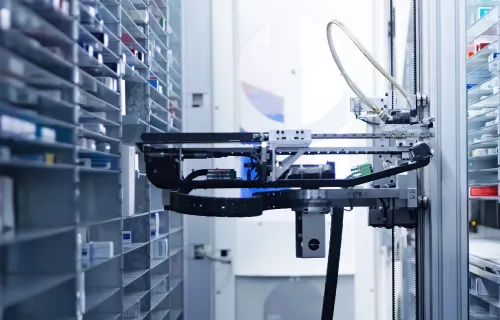There’s an odd expression that is used when there is, perhaps, shocking news or a sudden realization. A person might say that “it hit them like a Mack truck.” Often times, this figurative phrase has a negative connotation, but in my case, it was a bit more literal, and certainly a sudden realization.
I was driving in the outskirts of our Nation’s Capital, when this truck (pictured below) caught my eye. To me, this is a literal example as to how blockchain technology is hitting the transportation and logistics industry like a Mack truck – but in a good way.
If you have been following my other blogs, which build on our blockchain story from way back in 2017 (CGI integrates blockchain with conventional trade finance platform), I can now add that our team at CGI has decided to venture into the next most common trade function that could use a serious boost from innovation. We decided to tackle supply chain processing from the perspective of large manufacturing customers who interact with banks using CGI Trade360 software as a service. These large clients look to their bank to “finance” the trade transactions, whether it be from the supplier or buyer side.
So, if we fast forward to today, the objective of adopting blockchain remains the same—to ensure the highest level of trust and automation in supply chain management. This is happening at a pace that has never been faster. Seeing the truck emblazoned with the message, “this is a real shipment powered by blockchain,” was a welcome indicator and confirmation of the industry’s movement here in the U.S.
How supply chain transactions work today
Next, let’s examine the traditional process behind this picture, before blockchain. If we consider that whatever supply this truck is carrying, it was most likely, at some point, initiated by a purchase order placed by a company (“buyer”) that needed the supplies. The producer of the supplies (“supplier”) received the purchase order and took some time to manufacture the supply. Then, the supplier shipped the goods to the buyer. Once shipped, the supplier invoiced the buyer for payment. In most cases, the supplier required the buyer to show its ability to pay for the order, and the supplier financed the manufacturing through its bank. There is a whole slew of other organizations involved beyond the buyer, supplier and their corresponding banks, such as the shipping company and customs in both countries in case of international trade.
So, how does the supplier trust that the buyer has the ability to pay? Currently, the supplier asks for documents such as the purchase order, letter of credit or financing document. The supplier works with its bank to secure the financing, which may require some of the same documents and, often times, even more documents.
As we think through this exchange of information, how do these organizations trust each other to do their job? Just imagine how much time is spent by each one of these entities to protect their own interests and to reduce their risks by requiring documentation and inspections in order to offer their services? All of this takes time, which in most cases costs money. In some cases, the loss of time and money rooted in fraudulent trade documentation can be very great – into the hundreds of millions of dollars.
Going a step further, let’s look at the underlying technology that enables these transactions today. Most of the sellers and buyers use some form of customer relationship management (CRM), such as Salesforce, for their order-processing platform. It’s here that the corporation creates and maintains the purchase order, gathers the bill of lading and other documents required for the successful execution of transaction. Most banks use software platforms and portals, such as CGI Trade360, to help them execute and manage the back-office administration of their trade transactions. They are able to trace the transaction, perform know-your-customer (KYC) verification of their corporate customers’ customers, and keep all the financing contractual, accounting and supporting materials in one neat and tidy place.
Using blockchain to transform the supply chain
So, what is missing in today’s environment and ecosystem is a proper meshing or melding of the CRM systems to the major trade back-office platforms. It is here, in a pinpointed and rather dramatic way, that the proverbial “rubber needs to meet the road”—no pun intended!
As we take a pause and look back at the picture of the truck above, it’s time to ask, “What’s so great about blockchain?” Here’s my answer: Since distributed ledger technology (DLT) transactions are “approved” via a consensus, it is not possible for one entity to unilaterally execute a transaction. Therefore, the factor of trust increases, especially as in our case, both the supplier and its bank agree on the documentation (shared), which sets into the motion the financing and approval of the underlying order to begin manufacturing. Thereby, blockchain/DLT not only increases trust, but also reduces transaction processing and auditing time. It also enables and speeds the ability to share data, which in turn, eliminates the need for some extraneous, repetitive, inter-organizational communication. In the same fashion, the buyer and supplier “agree” on the terms of the purchase order, which can also be observed and accepted by their banks—all in near real-time—assuming that the rules for transaction approval can be automated.
With all of this in mind, CGI has teamed up with Salesforce to leverage Salesforce Blockchain, a blockchain platform natively integrated into CRM. We are working to build a market-ready solution that easily enables large corporations to conduct their businesses with the trust, speed and heightened security unique to a blockchain/DLT underpinning. In our controlled proof of concept (POC), we have designed for both the suppliers’ and buyers’ CRMs the ability to connect with their banks’ trade platform through a blockchain network, which is also offered by Salesforce. We enabled the most typical buyer and seller scenarios and witnessed the end-to-end processing and mimicked messaging with their corresponding CGI Trade360 banks. The POC showed the near real-time nature of the transactions and the potential cost and labor savings driven from the wide range of efficiencies, largely attributed to the standardized and streamlined sharing of data and the rapid DLT consensus in approving the transactions across the entire span of supply chain participants (including buyers, sellers, banks, freight forwarders and customs). Our next phase is to look to a real shipment powered by blockchain/DLT via Salesforce and financed by a CGI Trade360 bank client – stay tuned!






